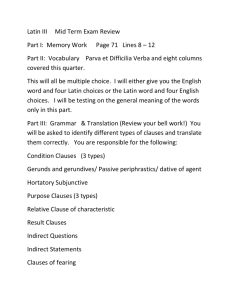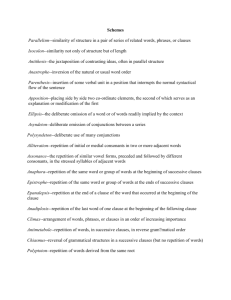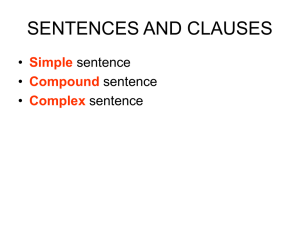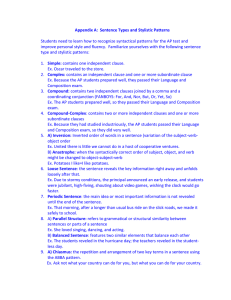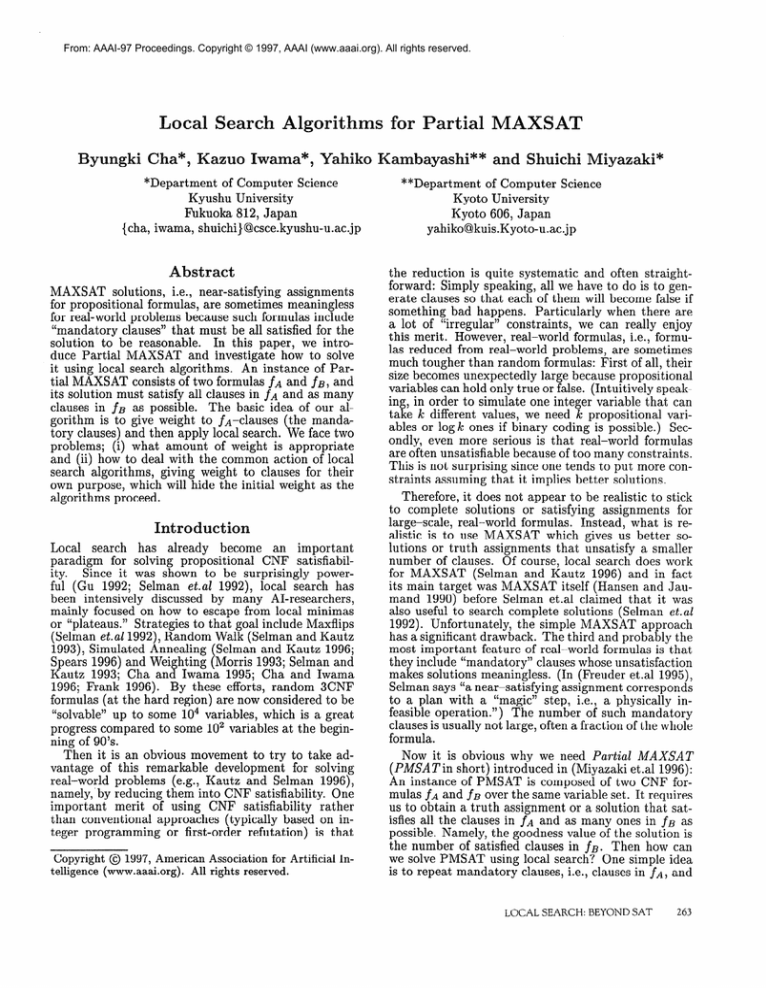
From: AAAI-97 Proceedings. Copyright © 1997, AAAI (www.aaai.org). All rights reserved.
Local Search Algorithms for Partial MAXSAT
Byungki Cha *y Kazuo Iwama *, Yahiko Mambayashi** and Shuichi Miyazaki*
*Department
of Computer Science
Kyushu University
Fukuoka 812, Japan
{cha, iwama, shuichi)@csce.kyushu-u.ac.jp
Abstract
assignments
MAXSAT solutions,
i.e., near-satisfying
for propositional
formulas, are sometimes meaningless
for real-world problems because such formulas include
“mandatory
clauses” that must be all satisfied for the
solution to be reasonable.
In this paper, we introduce Partial MAXSAT and investigate
how to solve
it using local search algorithms.
An instance of Partial MAXSAT consists of two formulas fA and f~, and
its solution must satisfy all clauses in fA and as many
clauses in fB as possible.
The basic idea of our algorithm is to give weight to fA-clauses(the mandatory clauses) and then apply local search. We face two
problems;
(i) what amount of weight is appropriate
and (ii) how to deal with the common action of local
search algorithms,
giving weight to clauses for their
own purpose, which will hide the initial weight as the
algorithms proceed.
Introchction
Local search
has already
become
an important
paradigm
for solving propositional
CNF satisfiability.
Since it was shown to be surprisingly
powerful (Gu 1992; Selman et.aZ 1992), local search has
been intensively
discussed
by many AI-researchers,
mainly focused on how to escape from local minimas
Strategies to that goal include Maxflips
or “plateaus.”
(Selman et.& 1992), Random Walk (Selman and Kautz
1993), Simulated Annealing
Selman and Kautz 1996;
Spears 1996) and Weighting fMorris 1993; Selman and
Kautz 1993; Cha and Iwama 1995; Cha and Iwama
1996; Frank 1996). By these efforts, random 3CNF
formulas (at the hard region) are now considered to be
“‘solvable” up to some 10” variables, which is a great
progress compared to some lo2 variables at the beginning of 90’s.
Then it is an obvious movement to try to take advantage of this remarkable
development
for solving
real-world
problems (e.g., Kautz and Selman I996),
namely,‘by reducing them into CNF satisfiability.
One
important
merit of using CNF satisfiability
rather
than conventional
approaches
(typically
based on integer programming
or first-order
refutation)
is that
Copyright @ 1997, American Association for Artificial Intelligence (www.aaai.org). All rights reserved.
**Department
of Computer
Kyoto University
Kyoto 606, Japan
yahiko@kuis.Kyoto-u.ac.jp
Science
the reduction
is quite systematic
and often straightforward: Simply speaking, all we have to do is to generate clauses so that each of them will become false if
Particularly
when there are
something
bad happens.
a lot of “irregular”
constraints,
we can really enjoy
this merit. Mowever, real-world
formulas, i.e., formulas reduced from real-world
problems, are sometimes
much tougher than random formulas: First of all, their
size becomes unexpectedly
large because propositional
variables can hold only true or false. (Intuitively
speaking, in order to simulate one integer variable that can
take Ic different values, we need k propositional
variables or log Ic ones if binary coding is possible.)
Secondly, even more serious is that real-world
formulas
are often unsatisfiable
because of too many constraints.
This is not surprising since one tends to put more constraints assuming that it implies better solutions.
Therefore, it does not appear to be realistic to stick
to complete
solutions
or satisfying
assignments
for
large-scale,
real-world
formulas.
Instead, what is realistic is to use MAXSAT which gives us better solutions or truth assignments
that unsatisfy
a smaller
number of clauses. Of course, local search does work
for MAXSAT
(S e 1man and Kautz 1996) and in fact
its main target was MAXSAT itself (Hansen and Jaumand 1990) before Selman et.al claimed that it was
also useful to search complete solutions (Selman et.aE
1992). Unfortunately,
the simple MAXSAT approach
has a significant drawback. The third and probably the
most important
feature of real-world. formulas is that
they include “mandatory”
clauses whose unsatisfaction
makes solutions meaningless.
(In (Freuder et.al 1995),
Selman says ‘(a near-satisfying
assignment corresponds
to a plan with a “magic” step, i.e., a physically
infeasible operation.“)
The number of such mandatory
clauses is usually not large, often a fraction of the whole
formula.
Now it is obvious why we need Partial MAXSAT
(PIMSATin short) introduced
in (Miyazaki et.al 1996):
An instance of PMSAT is composed of two CNF formulas $Aand fB over the same variable set. It requires
us to obtain a truth assignment
or a solution that satisfies all the clauses in fA and as many ones in fB as
possible. Namely, the goodness value of the solution is
the number of satisfied clauses in fB. Then how can
we solve PMSAT using local search? One simple idea
is to repeat mandatory
clauses, i.e., clauses in fA, and
LOCAL SEARCH: BEYOND SAT
263
then to apply local search for obtaining
MAXSAT solutions. Actually we do not have to repeat clauses but
can give weight to each clause.
The objective of this paper is to investigate how this
simple idea works. We mainly focus on two problems:
(i) What amount of weight given to mandatory
clauses
is appropriate?
(ii) Local search algorithms
also give
weight to clauses for their own purpose. This weighting will hide the initial weight given to the mandatory
clauses as the algorithms proceed, which might become
a significant
obstacle against our goal, i.e., trying to
satisfy all mandatory
clauses.
For experiments,
we used not only random 3CNF
formulas but also a typical real-world
formula which
is to obtain a class-schedule
table of universities.
The
data were taken from the real database of CS department, Kyushu University
(Miyazaki et .a1 1996)) whose
size is not so large but somehow realistic
(60 students, 30 courses, 13 faculties, 3 class rooms and 10
time-slots).
The formula includes 900 variables .and
some 300,000 clauses out of which some 2000 ones are
mandatory.
This is obviously a nice example for claiming the usefulness of Partial MAXSAT.
Why Simple
MAXSAT’
We first take a look at why simple MAXSAT does not
work using the class-schedule
example.
The notation
in this paper is as follows: A literal is a (logic) varz’a&
z or its negation ZZ. A clause is a sum (disjunction)
of one or more literals.
A (CNF) formula is a product (conjunction) of clauses. A truth assignment is a
mapping from variables into (true, false} or { 1, 0). A
formula f is said to be satisfiable if there is a truth
assignment
which makes all the clauses true; such an
assignment
is called a satisfying truth assignment.
An instance of the class-scheduling
problem consists
of the following information:
(i) A set CS of students,
cp of professors, CR of classrooms,
CT of timeslots
and CC of courses.
(ii) Which courses each student
in CS wishes to take, e.g., student
s wants to take
courses cr , c2 and cs. (iii) Which courses each professor in Cp teaches, (iv) Which timeslots each professor
* cannot teach, (v) Which courses each classroom cannot be used for (because of its capacity).
(vi) Which
timeslots each classroom cannot be used for, and so
on.
Now we generate a CNF formula from this information
Let A,B and C be the numbers of the total
courses, timeslots and classrooms.
Then we use variables zi,j,k(l
5 i 5 A, 1 5 j 5 B, and 1 5 k 5 C).
Namely ~i,j,k = 1 means that course i is assigned to
timeslot j and room k. Hence a particular
truth assignment into those variables ~,j,k can be associated
with a particular class schedule. Here is the translation
algorithm:
Step I. For each ir,i2, j, L(ir # iz), we generate the
clause (zil,j,lcV
xiz ,j,h), which becomes false if different
courses ir and i2 are taught in the same room at the
same time.
Step 2.
Suppose
for example
that
professor
pr teaches courses ~2, c4 and ~5.
Then for each
we
generate the clauses (x2,j,kl v
j&l, k2(h
#
k2),
-
24,j,hz
264
--
> A (XZ,j,kl
v 25,j,kz
)A(Zq,j,lclVS
5,j,h
> A hj,h
CONSTRAINT SATISFACTION & SEARCH
v
Q,j,d
A
b4,j,h
v
z4,j,lcs
> A
~
(X5,j,k~
v
~
25,j,k,).
If
two
courses (including
the same one) taught by the same
professor pr are assigned to the same timeslot and different rooms, then at least one of those clauses becomes
false. We generate such clauses for each of all the professors.
Step 3. For each i, we generate the clause (xi,r,r V
which becomes false if course ci
X&1,2
v . . . V xi,~,~)
does not appear m the class schedule.
Step 4. Suppose for example, student sr wants to
take courses cl, ~3, c5 and cs. Then for each j, kr , I&, we
-generate h,j,hl
xS,j,h
> A (x3,j,h
V x3,j,g,)
--
A (xl,j,al
V X5,j,/cz
~
> A (Xl,j,/c,
V
-----)A(ZQ,j,lclVZg,j,lcz)A(55,j,W1V
vx5,j,h
are assigned to the
Ift wo of those four courses
same timeslot, then one of these six clauses becomes
false. Construct
such clauses for all the students.
Steps 5 - 7. More clauses are generated by a similar
idea according to the other constraints
(omitted).
To obtain a specific benchmark formula, we used the
real data of the CS department,
Kyushu University.
It
involves 30 courses, 10 timeslots, 3 rooms, 13 professors
and 60 students,
where each professor teaches two or
three courses and has two or three inconvenient
timeslots. Each student selects eight to ten courses.
It
should be noted that this formula, say f, is probably
unsatisfiable
because the request of students is so tight
(there are ten timeslots and many students select ten
courses).
Now what happens if we try to solve this f using
simple MAXSAT? According to our experiment,
it was
not hard to obtain a solution that unsatisfies only 15
clauses out of the roughly 300,000 total ones. It might
seem good but actually not: The result, namely the
obtained class schedule, did not include eight courses
out of 30. Also, there were five collisions of two courses
in the same room at the same time and so on. Namely
the number of the unsatisfied clauses is small but most
of them are mandatory;
if one of them is not satisfied
then the solution includes a fatal defect.
-1.
artial MAXSAT
Recall that an instance of PMSAT is composed of two
CNF formulas fA and fB. We have to obtain a solution
(an assignment)
that satisfies all the clauses in fA and
as many ones in f~ as possible.
Generally speaking,
there iS an implicit assumption
such that fA must be
“easy,” because it would be otherwise hard to obtain
any solution at all regardless of its goodness. One example of this easiness is that fA includes either only
positive literals or only negative ones which we call
uni-polar.
It seems that PMSAT has a large power of “simulating” other combinatorial
optimization
problems even
under the easy-fA assumption:
For example,
there
is an approximation
preserving reduction from MAXClique to PMSAT with uni-polar fA. (Note that MAXClique is one of the hardest optimization
problems
that is beheved to have no approximation
algorithms
of approximation
ratio n’-’ or better (Hastad 1996).)
More formally we can prove that there is a polynomialtime algorithm that, given a graph G, outputs (fA, f~)
which meets the following conditions:
(i) fA is uni-
polar. (ii) There is a polynomial-time
algorithm that
computes a clique C of G from a solution 2 of (f~, f~)
such that the approximation
ratio of C is L iff the approximation
ratio of 2 is tE.
The reduction is pretty straightforward:
For a graph
G with n vertices ~1 through vn, we use n variables zr
through zn.
f~ is the product of clauses (z V q)
such that there is no edge between vi and 7-j. Note
that fA contains only negated variables.
f~ is set to
is almost
be (~1) A (~2) A - - - A (cc,). Its correctness
obvious: From a solution (an assignment)
of (f~, fB),
we can compute a clique easily, namely, by obtaining a
set of vertices vi such that zi is set to be true. Since all
the clauses in fA are satisfied, no two vertices vi and vj
being unconnected
are not in the set. In other words,
the set of vertices constitute
a clique. Note that it is
widely believed that there is no such approximationpreserving reduction form MAX-Clique
to the normal
MAXSAT.
A bit harder example is a reduction
from MPNColoring, also known as a hard problem (Bellare et.al
1995). This time, we use n2 + n variables xi,j (1 5 i 5
n, 1 < j 5 n) and xj (1 2 j 5 n). Setting xi,j = 1
means that vertex vi 1s given color j. f~ consists of the
following two groups of clauses: (a) For each 1 5 i 5 n
and different jr and j2, 1 5 jr, j2 5 n, we generate
). (b) For each 1 5 j < n and different 2”r
(2i,jlV2i,jz
and i2, 1 5 ir, is 5 n, such that-- there is an edge between vi, and vi2 9 we generate (xi1 ,j V xi2 ,j). A clause
in (a) becomes false if a single vertex is given two or
more different colors and a clause in (b) becomes false
if two connected vertices are given the same color. ~JJ
is written as
fBl+ satisfied, and since only one clause (zj ) becomes
false, the number of satisfied clauses does not decrease.
Thus, without loss of generality, we have to consider
Ody
S,SSignmentS
that Satisfy fA, f&i for all i and
$B2 j for all j. Then if color j is actually used for some
vertex, then the variable xj must be set to 0 since at
least one (xi,j V q) becomes false otherwise. Thus the
clause (zj) under this assignment is false. Otherwise, if
the color j is not used then all zi,j, 1 5 i 5 n, are true
by themselves and hence we can make (zj) true. As a
result, the number of unsatisfied clauses in fB is equal
to the number of colors that are needed in the proper
coloring. In other words, satisfying more clauses in fB
means better coloring (fewer colors).
0ur basic idea of solving PMSAT is quite simple: We
repeat each clause in f,4 (or equivalently
we can give
initial weight to clauses in f,4 but we will seldom use
this expression to avoid possible confusion between this
weighting and the other type of weighting carried out
by local search algorithms).
Then we simply apply local search algorithms
to obtain a solution that (hopefully) minimizes the number of unsatisfied clauses. As
local search algorithms,
we tested two popular ones
in this paper; one is based on the so-called weighting
method and the other is based on @SAT+RandomWalk. In more detail, the former program (developed
by the authors) adds +I to the weight of each clause
that is not satisfied at the current assignment whenever
the current assignment
is a local minima.
The latter
was developed by Gang et.al (Liang et.al 1996) that is
claimed to be one of the fastest GSAT-type
programs.
Initial Weighting St sat egies
where
each f&i
xi,2 v * * -V%,TZ)
consists
and fBa,j
of the single clause (xi,1 V
consists of n clauses (TiT$lYjJ
for 1 5 i 5 n.
This reduction
preserves approximation
in the following way: First of all, one can see that if an assignment satisfies all the clauses in fA, then (i) each vertex
is given at most one color and (ii) no two connected
vertices are given the same color. But it can happen
that no color at all is assigned to some vertex. We next
show that if we wish to satisfy as many clauses in f~ as
possible, what we should do is to satisfy all the clauses
Suppose that a clause in f~,,~
in fB,,, through fB1,,.
is not satisfied. That means the vertex vi is not given
any color. Then we can satisfy it by setting xi,j = 1
for some j such that xi! ,j = 0 for all i’, i.e., by giving a
color j, which is not currently used, to that vertex vi.
clearly this change keeps all the clauses in $A satisfied,
and by this change, at most one clause (pi, v q) in
jBz.i changes from satisfied to unsatisfied.
Therefore
the number of satisfied clauses does not decrease at
least. Similarly we should satisfy all the clauses ~~~~~
clause
through ~Bz.~ because if there is an unsatisfied
in f&j) we -‘can satisfy it by setting zj = 0. Again, this
change keeps all the clauses in fA and f&1 through
As an extreme case, suppose for example that a single
clause in fA is repeated K + 1 times where K is the
number of all the clauses in fB and that fA is “easy”
to be satisfied.
Then to satisfy one more (original)
&We
in fA
pays even if it makes all the ChSeS
in fB
false in the sense that the number of unsatisfied clauses
decreases by at least one. It is very likely that the localsearch algorithm first tries to satisfy all the clauses in
PA and after that it then tries to satisfy others (i.e., in
fB> as many as possible while keeping fA all satisfied.
That is exactly what we want.
Unfortunately
this observation
is too easy: After
reaching some assignment
that satisfies all IA, the
local-search algorithm will never visit any assignment
that makes fA false because such an assignment
increases the number of unsatisfied clauses too large due
to the repetition of fA_clauses.
That means the search
space is quite restricted,
which usually gives a bad
effect to the performance
of local-search
algorithms.
This turned out to be true by the following simple experiment:
Suppose that both fA and jB are random
formulas and the number of clauses in fA is one ninth
the number of clauses in fB. Also suppose that the
local search has already reduced the number of unsatisfied clauses well, say, to 20 (i.e., fA is expected
LOCAL SEARCH: BEYOND SAT
265
to include two such clauses on average).
Then it often happens that all the clauses of fA are satisfied by
chance without using any repetition
of f,J-clausesat
all. However, if we assure the satisfaction
of fA by
the (heavy) repetition,
then it becomes easier to satisfy fA-clauses but it becomes very hard to reduce the
number of unsatisfied
clauses in fjg, say, to less than
50.
Thus, we do need the repetition
but its amount
should be minimum.
Then how can we compute an
appropriate
amount of the repetition?
The idea is to
make some kind of balance between fA and fB. To do
so, we first suppose that the current assignment
is not
too bad, i.e., almost all fA-&kuses
are already satisfied and many fB-dausesare also satisfied. Under this
assumption,
we can imply several conditions
on the
current value of each variable. Using this information,
we can then compute the average number, say, iV, of
fB_claUses that are currently satisfied but will become
unsatisfied when we change the assignment
so that one
new fA--clause will become satisfied. This number N
is a good suggestion
of the number of repetitions
of
each fA-chse. An example of this calculation
for the
class-schedule formula will be given in the next section.
Restart and Reset Strategies
As shown in (Cha and Iwama 1995; Cha and Iwama
1996; Frank 1996), the weighting method is very fast in
terms of the number of cell-moves until the algorithm
gets to a satisfying assignment.
However, it takes more
time to carry out a single cell-move.
Actually,
the
GSAT-type
program by Liang et.al, which we will call
LWM hereafter, can make five to ten cell-moves while
our weighting-type
program carries out a single cellmove. (This difference of performance
is also due to
implementation
at least in part.)
Thus it is not an
easy question whether should be preferred.
When we use weighting-type
local search for PMSAT, special care must be needed:
Recall that each
fA_claUSe is repeated,
for example, ten times. However, the algorithm
can give weight to any clause, either in fA or in fB, if that Clause is unsatisfied
at a
local minima. Note that giving +l weight has exactly
the same effect as repeating that clause one more time.
Also it should be noted that the total amount of weight
given by the algorithm is surprisingly
large especially
when the program is run for long time. Therefore it can
well happen that the initial repetition
of fA-chses
will soon be overwhelmed by the vast amount of weight
given by the algorithm.
We can observe this phenomenon
in Fig. 1, which
shows how the number of unsatisfied clauses in fA (denoted by A-Clauses) and in fB (denoted by B-Clauses)
changes as the algorithm proceeds. The formula used
is a random 3SAT formula of 400 variables, 4000 (total) clauses and 400 fA-&buses.
Each fA-chuseis repeated 100 times. (We also obtained very similar data
for a formula of 800 variables,
8000 clauses and 800
f~-&%Uses.)As one can see, the number of unsatisfied
fA_claUses drops immediately
to zero thanks to the
repetition,
but when the number of steps (cell- moves)
increases, it leaves from zero at some moment, say, T,
and never comes back to zero. Namely, the effect of
266
CONSTRAINT SATISFACTION &I.SEARCH
the initial repetition
of fA_clauses dies at the moment
T and it is totally nonsense to continue the algorithm
after that.
Then what should be done at that moment T? A
simple answer is to stop the current search and restart
the algorithm completely from the beginning (i.e., from
a randomly
selected initial assignment).
We call this
version RESTART. Another possibility is to reset only
the weight given by the algorithm
so far and to continue the search from the current assignment.
This is
called RESET. The next question is how to decide this
moment T. Since the moment depends on the total
weight given by the algorithm
so far, one reasonable
way is to decide it by the number of local minimas
visited by the algorithm
so far. (Recall that the algorithm gives weight whenever it gets to a local minima.) It is denoted by an integer parameter,
Maxflips,
(as Maxflips = 100) which means that the algorithm
restarts (or resets) after it has visited local minimas
Maxflips times.
Experiments
As mentioned
in the preceding
section,
we tested
three algorithms,
RESTART,
RESET and LWM. The
value of Maxflips was set to 400 since that is not too
small compared to the moment 2’ discussed previously.
(Note that if Maxflips is too small, we may never be
able to reach good solutions at all. So, it is safer to
make this value large but it may lose the efficiency.)
Random formulas are denoted as ra - b - c where a,
b and c are integers that show the numbers of variables, the whole clauses and f,J-clauses,
respectively.
We also used the class-schedule
formula for which the
clauses are divided into fA and fB as follows: fA includes all the clauses generated at Steps I and 2 (for
the obvious reason). The clauses generated at Step 3
are also important.
However, if we put them into fA,
then fA becomes not uni-polar.
So, we did not do so
but repeated (zi,r,r VQJJ V- - *VZ~,B,C) Ki times where
Ki is the number of students who select course ci, and
put them into fB. This does not lose sense because if
ci is missing, then it gives inconvenience
to only the
Ki students.
All the other clauses are put into fB.
Let us take a look at how to calculate the appropriate repetitions
of fA-clausesin the case of this classschedule formula:
Suppose that we are now close to
a good solution, namely the current assignment
looks
like the one such that for each i only one of xi,j,k,
B 2 j 5 B and 1 5 k 5 C, is 1 and all the others 0.
Furthermore
suppose that there is an fA-clause,say,
(xi 1 1 V m)
that is now 0, i.e., both xi 1 1 and x. 1 r
are’ i.
/A-clauses must be satisfied. ‘So let us”&e
what happens if we try to flip the variable xi,r,r from
1 to 0. Apparently
this fA-clause (xi,r,r Vxj,l,l)
is satisfied and fortunately
it does not cause any bad effect
to other fA-clauses(i.e., no such clauses change from
1 to 0).
We next observe how this flip (of zi,i,r from 1 to
0) changes the satisfaction
of fB-&uses. As for the
all-positive-literal
clauses generated in Step 3, (xi,r,r v
- - V z&B&)
is expected to change from 1 to 0. That
does not happen actually if some variable other than
ZQ,J_ is also 1, but this probability
is low according to
Ali’
l
#UNSAT
#UNSAT
1
-
““““‘I
- RESET
--- RESTART
;
i,
,
t ‘\ \
380
__. LWM
360
(
3201
0
(
,
20
10
Fig. 4
#STEPS(x 1000)
Fig. 1
,
,
,
(
1
40
30
#STEPS (x 1000)
GAT
12#d
‘,-_.iiETMioiTni:zwo1
/
-
I
I
RESET
RESTART
I
_--
:I
I
__. LWM
110
100
1
0
I
I
I
10
I
20
Fig. 2
#UNSAT
8
:
:
I
I
I
I
I
I
I
8
I
I
0
30
40
#STEPS (x 1000)
I
100
Fig. 5
I
I
,
I
300
500
#STEPS(x 1000)
l&
630 -;
:
- RESET
--- RESTART
-:
:
:
__. LWM
__. LWM
110
______________________;
II
II
I____________
;
I
‘-1I
‘--\_______.~~~~~~,~~~~~~----------~
570 1
I
0
I
IO
Fig. 3
I
I
!
I
I
100
1
I
#STE::
(x ,000;’
I
:
t
i
.’
J
II
~~~“_r_rrr~~_~_-_~-~-“--“~“-“~““-~”-~-I
I
I
t
0
20
1
100
Fig. 6
300
500
#STEPS(x 1000)
LOCAL SEARCH: BEYOND SAT
267
the nearly-good-solution
assumption
mentioned above.
Recall that this clause is repeated Ki times.
As for
the opposite clauses, i.e., the ones changing from 0 to
P, it is enough to only consider the clauses generated
in Step 4 (others are negligible).
Such clauses have
-the form of (~i,r,r V zit,1,6) and if this is 0, then it
means some student among the Ki ones wishes to take
both courses i and i’ which collide at timeslot P in the
current assignment.
We can assume that the number
of such students
is only a fraction of Ki. It is not
hard to see that Ki = ff on average where E and %
are the number of students
and the average number
of courses selected by a student, respectively.
(Recall
that A is the number of courses.)
Thus the number
of satisfied clauses in f~ decreases by roughly F_ As
a result, flipping zi,r,r from 1 to 0 increases satisfied
clauses by one in fA but decreases by T in f~. This
is the number N discussed previously, which is about
20 in our current example.
Figs. 2-4 show the performance
of RESTART,
RESET and LWM for random formulas,
i.e., for r4004000-400, r400-8000-800
and r800-8000-800,
respectively.
Each curve shows the number of unsatisfied
fB--clauses of the best solution (i.e., it satisfies all the
fA_claUSeS and most fB--clauses)
the algorithm
has
gotten by that number of steps (cell-moves).
(This
graph, in general, seems to be quite reasonable to show
the performance
of MAXSAT algorithms,
which never
appeared in the literature.)
Each graph shows the average of results for four random formulas. The number
of repetitions
for each fA-clause
is 100 for all experiments. Generally speaking, RESET appears to be the
best.
Figs.
5 and 6 show similar graphs for the classschedule formula.
The number of repetitions
for fAclauses is 20 and Maxflips = 2000 (Fig. 5) and 5000
(Fig.6). The current best result is a solution that includes 93 unsatisfied
(all f~) clauses, which was obtained after some 5 million steps. We also tested the
heavy weight (lOOO), but we were not able to get any
solution that contains less than 115 unsatisfied clauses.
Remark.
Very recently,
Nonobe
and Ibaraki
(Nonobe and Ibaraki 1996) used our data for the class
schedule and obtained a schedule table using a sophisticated CSP approach.
Their result is slightly better
than ours, i.e., the students have to abandon 86 courses
(almost the same as 86 unsatisfied clauses in our case)
in total, and they claim the result is optimal.
Concluding
Remarks
Because of the time limit, we were not able to conduct several experiments
including;
(1) experiments
to observe the effect of the number of repetitions
of
jA_claUSes, (2) experiments
to investigate
an optimal
value for Maxflips, (3) experiments
to test some different weighting strategies
that are suitable to PMSAT
and so on. It might be more important
to investigate
more basic requirements
for solving PMSAT. For example, completely different approaches like backtracking may work better for PMSAT. Also there may be
other methods to manage fA_clauses than simply repeating them.
268
CONSTRAINT SATISFACTION & SEARCH
The first and fourth authors are Research Fellows of
the Japan Society for the Promotion of Science and this
research was supported
by Scientific Research Grant,
Ministry of Education,
Japan, No. 0569 and 2273.
References
Bellare, M., Goldreich 0. and Sudan, M. (1995). Free
bits, PCPs and non-approximability
- Towards tight
results. Proc. FOCS-95, pp.422-431.
Cha, B. and Iwama, K. (1995). Performance
test of
local search algorithms
using new types of random
CNF formulas, Proc. IJCAI-95,
pp.304-310.
Cha, B. and Iwama, K. (1996). Adding new clauses
for faster local search, Proc. AAAI-96, pp.332-337.
Frank, J. (1996). Weighting
for Godot:
Learning
heuristics for GSAT, Proc. AAAI-96, pp.338-343.
Freuder, E.C., Dechter, R., Ginsberg, M.L., Selman,
B. and Tsang, E. (1995). Systematic
versus stochastic constraint
satisfaction,
Proc. IJCAI-95,
pp.20272032.
Gu, 9. (1992). Efficient local search for very largescale satisfiability
problems,
Sigart Bulletin,
Vo1.3,
No.& pp.8-12.
Hastad,
J. (1996) Proc. FOGS-96
Hansen, J. and Jaumard,
the maximum satisfiability
pp.279-303.
B. (1990). Algorithms
for
problem. Computing, 44,
Kautz, H. and Selman, B. (1996). Pushing the envelope: Planning,
propositional
logic, and stochastic
search, Proc. AAAI-96, pp.f194-1201.
Liang, D., Wu, Y. and Ma, S. (1996). Personal
munication.
com-
Miyazaki, S., Iwama, K. and Kambayashi,
Y. (1996).
Database queries as combinatorial
optimization
problems, Proc. International Symposium on Cooperative
Database Systems for Advanced Applications, pp.448454.
Morris, P. (1993). The breakout method for escaping
from local minima, Proc. AAAI-93, pp.40-45.
Nonobe,
nication.
K. and Ibaraki,
T. (1996). Personal
commu-
Selman, B. and Kautz, H.A. (1993). An empirical
study of greedy local search for satisfiability
testing,
Pro,. AAAI-93, pp.46-51.
Selman, B., Kautz, H. and Cohen, B. (1996). Local
search strategies
for satisfiability
testing,
DIMACS
Series in Discreet Mathematics and Theoretical Computer Science 26, pp.521-531, 1996.
Selman, B., Levesque, H.J. and Mitchell, D.G. (1992).
A new method for solving hard satisfiability
problems,
Proc. AAAI-92, pp.440-446.
Spears, W.M. (1996). S imulated
annealing
for hard
satisfiability
problems,
DIMACS Series in Discreet
Mathematics and Theoretical Computer Science 26,
pp.533-557.


